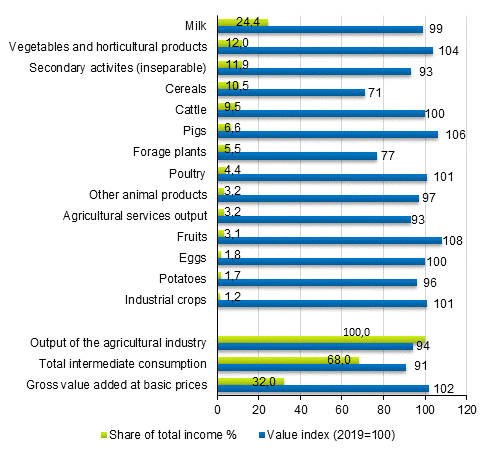Published: 11 December 2020
Value added in agriculture this year on level with the previous year
The current priced value of cereals and forage plants plummeted in 2020 by nearly 30 per cent compared with 2019. The volume of cereal production 1) decreased less sharply than the current value, by 13 per cent. In other respects, the decrease in the current priced value was due to the drop in cereal prices. By contrast, volumes and prices remained almost on level with the previous year in other product groups of agriculture. Although the output of agriculture calculated at current prices contracted by around EUR 300 million, according to the current estimate, the value of intermediate products will also decrease to such an extent that the current priced value of gross value added in agriculture and the volume will remain almost on level with 2019. The data derive from the Economic Accounts for Agriculture that are now published.
Share of agricultural product groups of total output %, and the current value index (2019 = 100) in 2020

The share of milk corresponds to nearly 25 per cent of the output in agriculture. The volume of milk output fell by just under one per cent from the previous year, and this year the price has been slightly higher than in 2019, so the current priced value of milk is assumed to remain almost on level with the previous year. Vegetables and horticultural products (12 per cent share of total agricultural output) and fruits (3.1 per cent share) are accounted for separately in the economic accounts for agriculture. The current-price value of both these product groups is estimated to grow this year. Thus, the significance of horticulture continues to grow in the income formation of agricultural and horticultural enterprises.
The current-price value of secondary production and ancillary activities practised by agricultural enterprises corresponds to nearly 12 per cent of the output of agriculture. Secondary production includes, for example, machine contracting and further processing of agricultural products. This year, the value of secondary production is estimated to contract slightly from last year.
The combined value of the output of cereals corresponds to nearly 10 per cent of the output of agriculture. In 2020, only the volume of oats grew slightly from the previous year, but due to lower prices than last year, the current value of oats decreased by good 10 per cent. The volume of wheat and barley dropped by around 20 per cent and the current priced value by about 35 per cent. The volume of rye production absolutely plummeted by good 60 per cent from the year before.
Meat production accounted for good 20 per cent of the agricultural output (beef 9.5%, pig husbandry 6.6% and poultry 4.4%). In addition, the share of egg production was 1.8 per cent. Both the price and volume of pork increased to such an extent that the current priced value is expected to rise by around six per cent from the previous year. The value of other meat production is expected to remain on level with the previous year. The group other animal products (the share 3.2%) includes such as fur farming. This year, the line of production in question has suffered considerably from the effects of COVID-19.
Based on the above-mentioned, the output of the agriculture industry at current prices is estimated to fall by just under EUR 300 million from the previous year. However, the value of intermediate consumption is estimated to decrease slightly more, by slightly over EUR 300 million. This estimate is mainly based on the fall in the prices of energy and fertilisers in 2020. In addition, feedingstuffs produced for own final use are counted as agricultural output after which it is subtracted from output as an intermediate product. The price of feedingstuffs produced for own final use is based on the price of marketable barley, so the lower price of barley compared to last year is visible both as a lower value of output and as a lower intermediate cost for feedingstuffs. When intermediate consumption is subtracted from the output, the result is gross value added. Gross value added at current prices is estimated to grow by around EUR 20 million from 2019. By contrast, the volume change of gross value added is estimated to fall by around two per cent from the previous year.
The data for Economic Accounts for Agriculture (EAA) are produced at Statistics Finland as part of the national accounts calculation. The compilation of EAA accounts is based on accounts harmonised and regulated by the EU. The accounts are compiled with uniform methods in all EU Member States. Data on all Member States can be found in Eurostat's database.
1) Volume refers to data from which the effects of price changes have been eliminated. Volume=quantity of reference year*price of comparison year. The volume change is usually made using a product or expenditure-based deflator. The volume sums are calculated by summing up as are current priced items.
Source: Economic Accounts for Agriculture (EAA), Statistics Finland
Inquiries: Hannu Maliniemi 029 551 2796, maataloustilastot@stat.fi
Head of Department in charge: Mari Ylä-Jarkko
Publication in pdf-format (262.6 kB)
- Reviews
-
- Long-term examination (11.12.2020)
- Tables
-
Tables in databases
Pick the data you need into tables, view the data as graphs, or download the data for your use.
Appendix tables
Updated 11.12.2020
Official Statistics of Finland (OSF):
Economic Accounts for Agriculture (EAA) [e-publication].
ISSN=2670-1006. 2020. Helsinki: Statistics Finland [referred: 16.4.2024].
Access method: http://www.stat.fi/til/eaa/2020/eaa_2020_2020-12-11_tie_001_en.html

